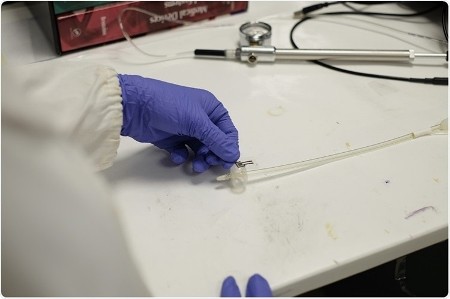Researchers at the Nanyang Technological University in Singapore in collaboration with the Massachusetts Institute of Technology have invented a quick, minimally invasive technology for sealing tears and holes in blood vessels. The technology uses a balloon catheter which when inserted into a blood vessel in the body can be guided to where a tear or hole has been located, and apply a glue patch called Voltaglue. Activated retractable electrodes called CATRE, carry an electrical current which is then applied to the patch which then seals the deal.
Why this caught my eye comes from my recent personal experience of having had an ablation procedure done to correct a heart arrhythmia known as Paroxysmal Atrial Fibrillation (aFib). It involved the insertion of two catheters into my femoral vein through an entry site near the groin. The procedure appears to have ended the aFib, but unfortunately, during the insertion into the vein, its wall was punctured creating a connection to the femoral artery. Called a fistula, it could be detected as a noise called a thrill when a stethoscope was used.
Fistulas happen in catheterization procedures. They are rare and when small will often close on their own. But in this case, a month after the procedure mine is still very much present and I am likely to have it repaired by a vascular surgeon.
My repair will happen before Voltaglue becomes standard medical practice. It is the invention of Terry Steele, an associate professor at the School of Materials Science and Engineering, Nanyang, and Manisha Singh, a doctor and associate professor from MIT’s Department of Mechanical Engineering.
Stated Steele in an article appearing in Medical Life Sciences News, “The system that we developed is potentially the answer to the currently unmet medical need for a minimally-invasive technique to repair arteriovenous fistulas (an abnormal connection between an artery and a vein) or vascular leaks, without the need for open surgery. With Voltaglue and the catheter device, we open up the possibility of not having to make surgical incisions to patch something up inside – we can send a catheter-based device through to do the job.”
In laboratory experiments using a pig’s heart, the Voltaglue patch was administered even in the high pulsatile pressures found in arteries. In one application it closed a 3 millimetre (0.118 inches) defect while blood was flowing by at 10 millilitres per minute.
Voltaglue’s sealant can be adjusted for hardness based on the amount of voltage applied to the patch. Called electrocuring, it provides a wide range of adaptability for dealing with various types of tissue from smooth arterial walls to uneven surfaces like vascular implants and grafts. The patch starts to set after 20 seconds and hardens within 3 to 5 minutes.
The Voltaglue technology can deal with blood vessels ranging from 7.5 to 30 millimetres in size which makes it suitable for repairing defects in the aorta, intestines, and oesophagus. The patch material is bioresorbable which means it degrades and dissolves after several weeks with the body’s own epithelial cells replacing the repaired tear or puncture.
It could be on the market by as early as 2025. The results of the inventors’ work has been published in a recent edition of Science Advances.
















